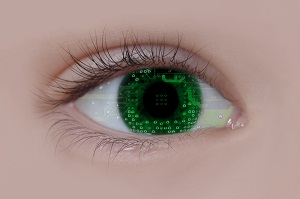 Eric and I find it hilarious that no matter what the situation, Ramsey (our golden retriever) always ends up smiling (… and panting). Regardless of whether we have just scolded her, chased her, fed her, etc., she always quickly reverts back to her pleasant facial expression. We call it her “default setting.”
Eric and I find it hilarious that no matter what the situation, Ramsey (our golden retriever) always ends up smiling (… and panting). Regardless of whether we have just scolded her, chased her, fed her, etc., she always quickly reverts back to her pleasant facial expression. We call it her “default setting.”
One of her favorite things to do is to chase her frisbee (Zogoflex Zisc). When Eric brings her in after a satisfying frisbee session, she runs to the top of the stairs, turns around, flops on her favorite vent (with cool air coming out), and pants with a huge smile on her face. Yes, I’m aware that what appears to be a smile is sometimes just her cooling down, but nevertheless, you can’t look at it for long and stay in a bad mood. She has a way of smiling me out of a lot of down moods.
When I was growing up, and even still today, I am not always aware of what my face is saying. In my mind I may think all is well, but my face sometimes shows signs of angry, frustration, fear, or confusion without my being aware. I vividly remember standing backstage at my community college, just minutes before the curtain opened. In my mind, I thought I was as cool as a cucumber, until our choir director asked me, out of the fifty or so people in the choir, if I was okay. I told him that I was, but I remember wondering why on Earth he asked me such a thing.
Later, when sharing the story with my choir buddy, and long time friend, she told me that I often got a freaked out look on my face. WHAT?! Me? The cucumber got a freaked out look on her face before performances? This is when the light bulb came on that my face and my brain don’t always get the same memos. Since then, I have observed other people’s faces. Sometimes I am quick to assume that people are not friendly because their faces look forlorn, or perhaps angry. However, after talking to them, or seeing someone else approach them, it is clear that they are not necessarily forlorn or angry at the time, it is just their face’s default setting.
Some of us have not been aware that our faces tell a story about us – even before anyone gets to know us. Maybe you are uncomfortable in new situations and your default setting is a look of disinterest. That look can tell others that you want to be left alone… when you are really wishing someone would reach out to you. Maybe you are a friendly type that draws people in because you are always smiling. There may be times you would prefer some solitude, but you find that you are always surrounded by people. Our faces give off messages every day, but we often don’t know what messages we are sending since we aren’t walking around with a mirror attached to our face.
Some arguments begin solely based on a facial expression. I can remember times in college when I thought a friend of mine was furious with me simply because I misread her facial default setting. We got into a number of arguments because I was so sure she was trying to “tell” me something with her face. It is too bad I did not consider this concept back then!
So, what is your default setting? What does your face normally indicate to others? Ask the people closest to you. Ask those who live with you currently, family members and friends with whom you grew up, co-workers at your job, fellow students at your school, or people you’ve known for a while at your church. Ask them to be completely honest with you with this question: “When you are not being engaged in conversation, but you are simply ‘there,’ what does your face default to?” Find out if there is a common default or even a situational default. Once you find out, ask yourself if it is a default setting that you prefer.
The easy thing about computers is that you can change your default settings with minimal effort. Unfortunately, changing your face’s default setting will take some practice. Try to have your face show what you want the world to see. If you want the world to see “friendly,” show a friendly face. Interestingly, our actions often follow the mood we’ve set. If you want to show confidence, show it! Have others remind you when you are reverting back to a negative default setting.
Our faces can do us a lot of good or get us into a lot of trouble. What we tell others with our expressions can open life doors or close life doors. Think of what would have happened if you were bitter and angry the entire day that you met your significant other – would your relationship ever have formed? Remember, your facial default setting can invite meaningful relationships or push away meaningful relationships. At this time in your life, as you prepare to be married, or work toward a better marriage, allow your default setting to empower you and your relationship. The most beautiful person with a negative default setting is not attractive, while someone with an average face and a bright default setting can light up a room. Check your default settings!
What does your default setting show to other people?
Leave a Reply